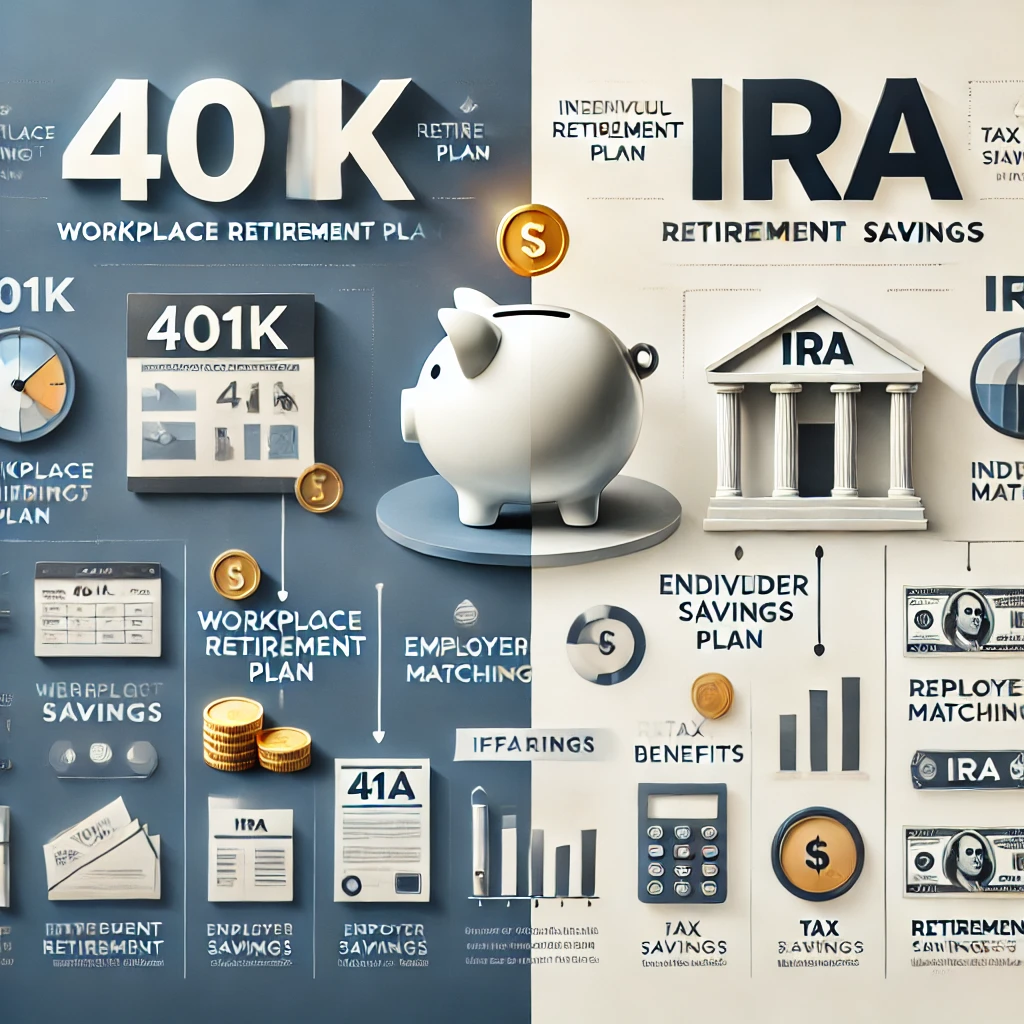401k vs IRA: Which is Better for Retirement?
Deciding between a 401k vs IRA for retirement savings can feel daunting. Both are excellent tools to secure your financial future, yet they differ in ways that might sway your choice. In this guide, we’ll explore what each offers, their benefits, drawbacks, and how they fit into your plans. Whether you’re new to saving or fine-tuning your strategy, understanding these options is key.
We’ll dive into eligibility, contribution limits, tax perks, and more. By the end, you’ll have a clearer picture of which—or both—suits you best. Let’s get started!
What is a 401k?
A 401k is an employer-sponsored retirement plan. You contribute part of your paycheck before taxes, and it grows tax-deferred until withdrawal. Many employers sweeten the deal with matching contributions—free money for your future.
For 2025, you can contribute up to $23,000 if under 50, or $30,500 with a $7,500 catch-up if 50+. These limits adjust yearly, so stay updated via the IRS.
Who Can Contribute to a 401k?
Only employees of companies offering a 401k can participate. Enrollment typically happens through payroll deductions, though some plans delay new hires. Check with HR for specifics. Self-employed folks can’t join a standard 401k but might opt for a Solo 401k, which mimics the traditional version with unique rules. If your job lacks a 401k, don’t worry—IRAs are an option.
What Are the Tax Benefits of a 401k?
Traditional 401k contributions lower your taxable income. Earn $60,000 and contribute $5,000? Your taxable income drops to $55,000. Growth is tax-deferred, taxing withdrawals as income in retirement. Alternatively, a Roth 401k uses after-tax dollars, offering tax-free growth and withdrawals. It’s ideal if you expect higher taxes later. Both options provide flexibility based on your tax outlook.
What is an IRA?
An IRA, or Individual Retirement Account, is a personal savings vehicle open to anyone with earned income. Unlike a 401k, it’s not employer-tied, giving you independence. Two main types exist: traditional (pre-tax, tax-deferred) and Roth (after-tax, tax-free withdrawals).
In 2025, contribution limits are $7,000 for those under 50, or $8,000 with a $1,000 catch-up for 50+. IRAs shine with diverse investment choices—stocks, bonds, ETFs—unlike the often-limited 401k options.
What Are the Different Types of IRAs?
Beyond traditional and Roth, IRAs include SEP and SIMPLE versions for self-employed folks or small businesses. SEP IRAs let employers contribute for staff, while SIMPLE IRAs allow both employee and employer inputs. For most, it’s traditional vs. Roth. Pick traditional if you expect a lower tax bracket in retirement, or Roth if you foresee higher taxes. Your current income and goals drive the choice.
Key Differences Between 401k and IRA
Here’s how 401k and IRA stack up:
- Eligibility: 401k requires an employer plan; IRA is open to all with income.
- Contribution Limits: 401k allows $23,000 vs. IRA’s $7,000 in 2025.
- Employer Match: Common in 401ks, absent in IRAs.
- Investments: IRAs offer broader options than 401ks.
- Fees: 401ks may carry higher costs; IRAs can be cheaper.
[Insert table: Comparison of 401k and IRA features]
Can I Have Both a 401k and an IRA?
Absolutely, and it’s a smart move for many. A 401k with an employer match is a no-brainer—free money! Then, an IRA adds extra savings with more investment control. However, if you have a 401k and deduct IRA contributions, income limits might apply. For 2025, single filers phase out deductions between $75,000 and $85,000 MAGI if covered by a workplace plan. No workplace plan? Deduct freely.
Pros and Cons
401k Pros and Cons
- Pros: High limits, employer match, easy payroll setup.
- Cons: Limited investments, potential fees, employer dependency.
IRA Pros and Cons
- Pros: Flexible investments, low fees, universal access.
- Cons: Lower limits, no match, income restrictions.
How Much Can I Contribute to a 401k in 2025?
For 2025, the IRS sets the 401k limit at $23,000 for those under 50. Over 50? Add a $7,500 catch-up, totaling $30,500. Employer matches don’t count toward this cap, boosting your savings. Limits may rise with inflation, so check annually. High earners or late starters love this roomy cap—it’s a chance to turbocharge retirement funds fast.
How Much Can I Contribute to an IRA in 2025?
In 2025, IRA limits are $7,000 for under-50 folks, or $8,000 with a $1,000 catch-up for 50+. This applies across all your IRAs—traditional or Roth combined. Smaller than a 401k’s limit, sure, but it’s perfect for extra savings or if you lack a workplace plan. Every dollar counts toward your future comfort.
Which is Right for You?
Choosing depends on your situation. Got an employer match? Max that 401k first. Want flexibility? Add an IRA. No 401k? Start with an IRA. Many blend both for optimal growth.
What Happens to My 401k If I Change Jobs?
Switch jobs? Your 401k options are: leave it (if allowed), roll it to a new 401k, shift it to an IRA, or cash out (avoid this—taxes and penalties hurt). An IRA rollover often wins for its investment variety and fee control. Under $5,000? Your old employer might force a payout, so plan ahead to keep your savings intact.
Conclusion
Navigating 401k vs IRA for retirement savings doesn’t have to stress you out. A 401k leverages employer perks, while an IRA offers freedom. Why not both? Start with a 401k match if available, then explore an IRA. For more tips, see our guide on retirement planning basics. Your future self will thank you!

